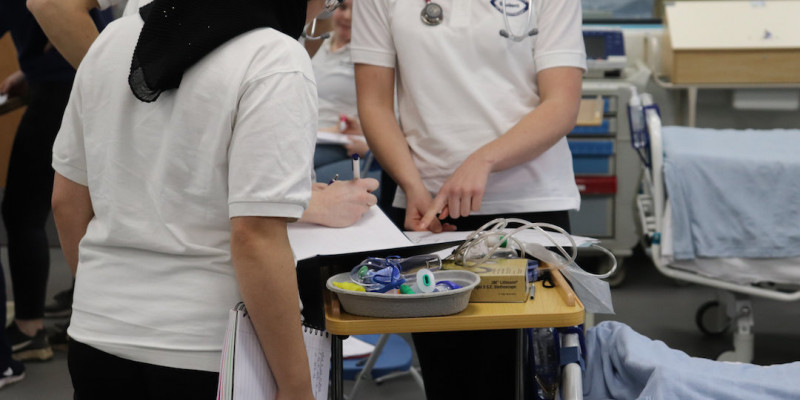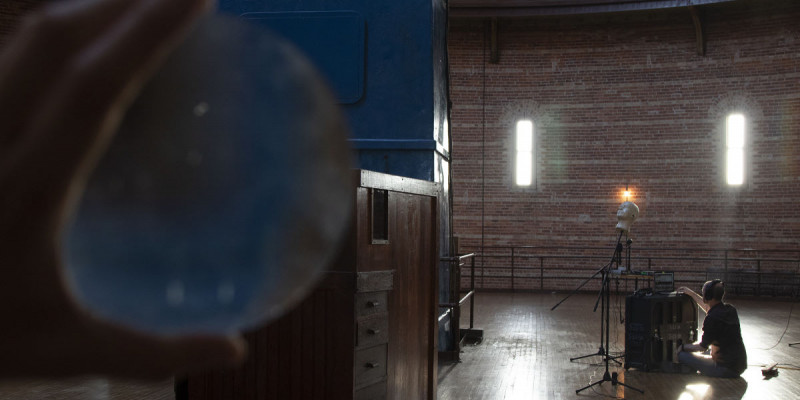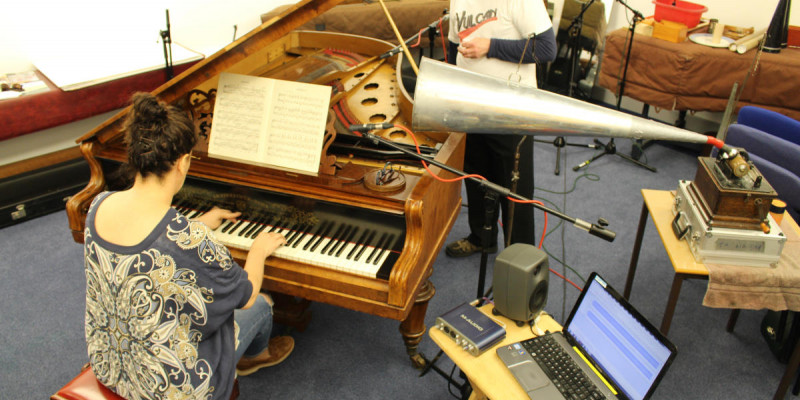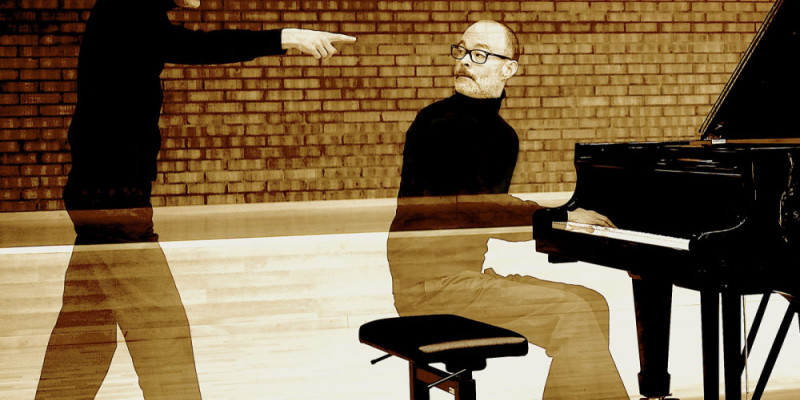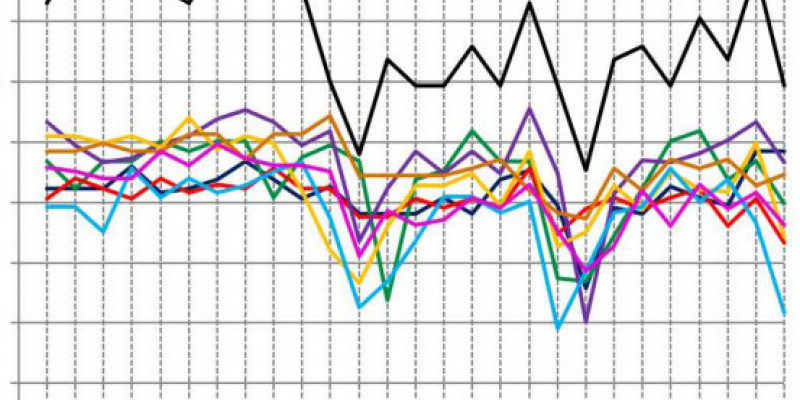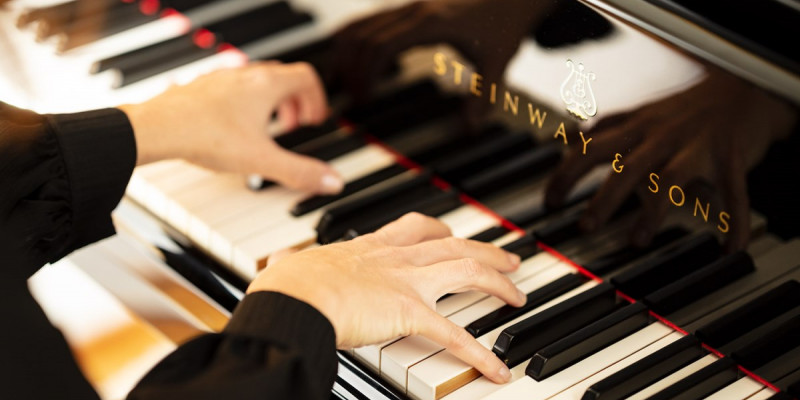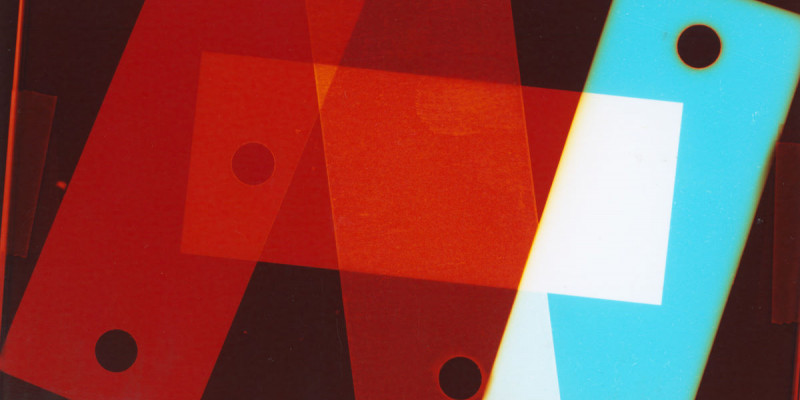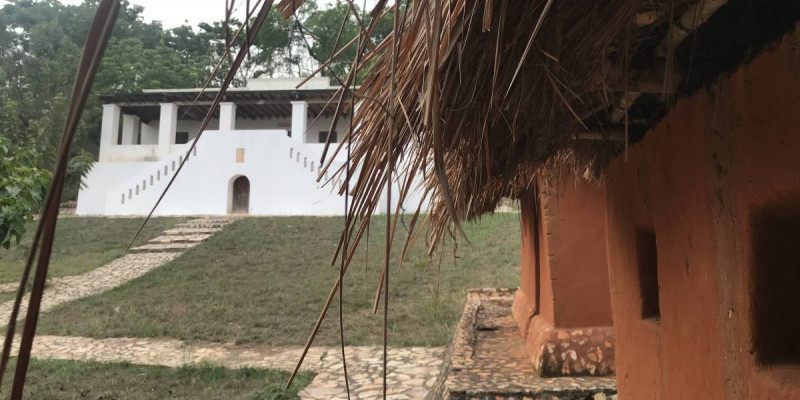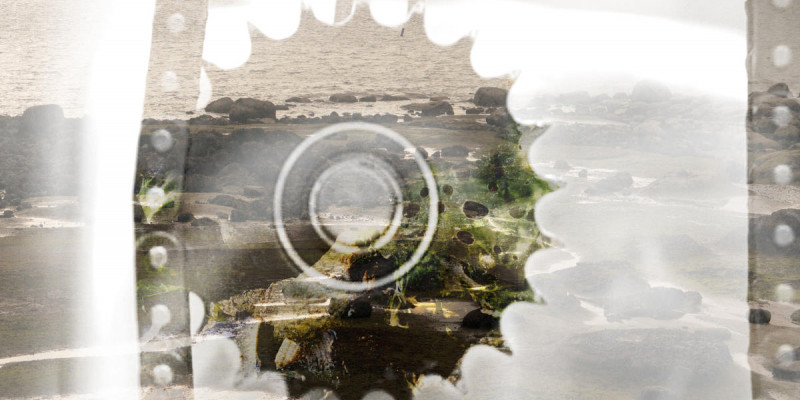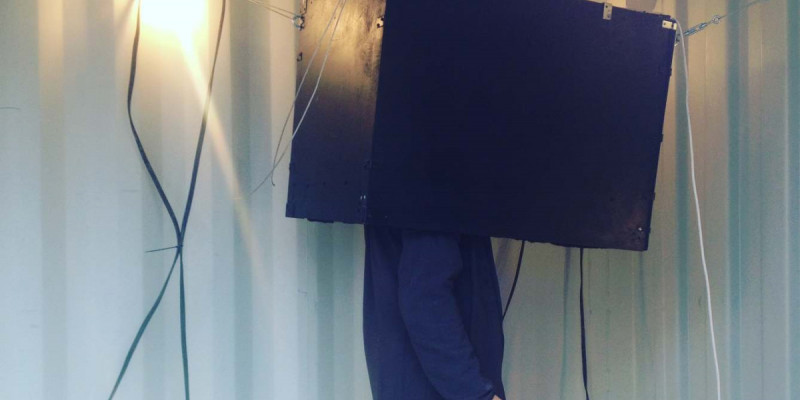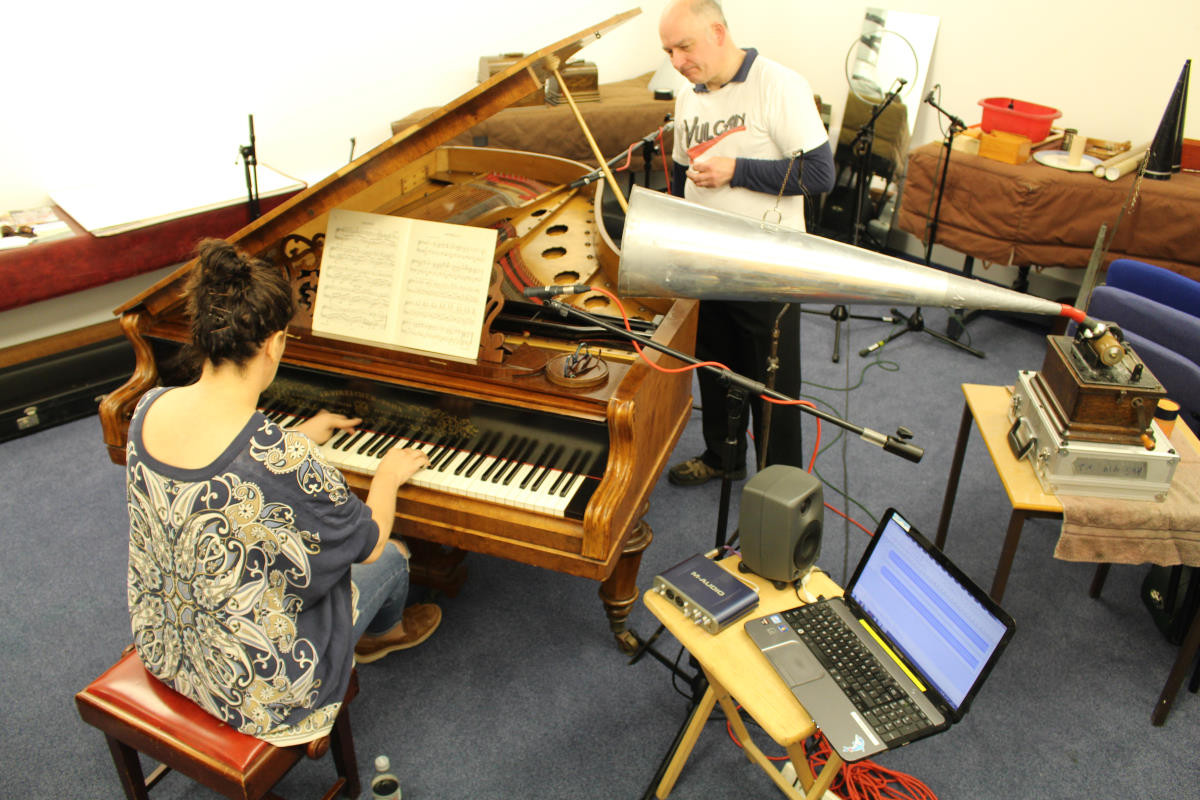
A chip off the old Block?
Abstract
This article introduces the practice of historically-informed recording. It starts by offering a brief definition of this practice before providing an outline of a working method used to produce historically-informed recordings. The paper goes on to introduces a particular example of this practice, in which the authors recreated four historic recordings originally made by amateur recording pioneer, Julius Block. In following the stated method, musicological research into Block’s technologies and recording techniques was supplemented with practical experimentation with a range of phonograph machines and associated technical equipment. In doing so, the authors explain how various phonograph makes and models, recording horns, cutters, wax cylinders, performance styles, instruments, and many more associated factors need to be taken into account when recreating early phonograph recordings. Attention is directed towards the notion of the historically-informed, and while the authors attempted to discover as much as possible about Block’s original recordings, most of the significant discoveries involved experimentation and testing rather than musicological research. The findings of the article are subsequently varied; although significant question-marks over the historical efficacy of the recreations remain, discoveries about the various phonograph machines, and their ability to record musical performances, demonstrate the relevance of historically-informed recording as a practice. More research is needed, and a range of pertinent areas for future exploration are offered.
Introduction
The term historically-informed has a long-standing association with musical performance. Indeed, for over half a century performers have been developing and describing strategies for delivering performances that are historically-informed, typically involving the use of period (or replica) instruments to present historic works, with some performers adopting performance conventions that were (ostensibly) used at the time such works were composed. There are, of course, many reasons for adopting such historically-informed performance strategies. For example, one might reason that historically-informed performances respect the composer’s intentions, or help to re-establish forgotten readings of musical texts, or even revive musical contexts, behaviours and customs that disappeared long ago. Whether these aims may be reasonably achieved, however, has been the subject of much debate among scholars, with critical notions of historical accuracy and authenticity taking centre stage.
Rather than rehearsing existing arguments about performance practices, this article borrows the term historically-informed and applies it to recordings. In doing so, it introduces a new form of practice that shall be termed historically-informed recording. Although this is an original term, the intentions behind its use may be easily grasped through the clear association with historically-informed performance; just as performers may use period instruments and performance conventions in their practice, so too may historically informed recordists use early recording technologies, and associated recording conventions, in theirs. By way of definition, therefore: historically-informed recording is a form of recording practice that aims to be faithful to the technologies, processes and conventions associated with specific historic recordings or, more broadly, historic recording eras.
Unfortunately, there are very few examples of historically-informed recordings that would fit this definition. The re-enactment of Arthur Nikisch’s recording of Beethoven’s Fifth Symphony at Royal College of Music (Kolkowski, Miller, Blier-Carruthers, 2015) is perhaps the closest fit. In this study, the authors attempted to recreate (or re-enact, as the accompanying article suggests) Nikisch’s original recording using early phonograph technologies and a full orchestra. The practical side of this ambitious study should occupy a significant place in any discussion about historically-informed recording practices, particularly given the details about how the re-enactment was planned and delivered from a technical perspective. The recording musicians were not historically-informed performers, however, and they were not using period instruments. In this sense, as is becomes clear from the findings and discussions below, aspects of the Nikisch re-enactment were limited.
To fully investigate the notion of historically-informed recording practice, the authors of this article decided to recreate four historic recordings made by recording pioneer, Julius Block. These recordings were chosen for a several reasons: Firstly, Julius Block purchased an Electric Phonograph, or class M machine, following a visit to Thomas Edison at his laboratory in Orange, New Jersey, in 1889. Block subsequently became an amateur recording enthusiast using only wax cylinders and his phonograph. As a result, we were able to recreate his recording processes with a relatively small range of specialist equipment. Secondly, Block’s cylinder collection includes some of the leading musicians at the end of the nineteenth century, including Pyotr Ilyich Tchaikovsky, Leo Tolstoy, Nicolai Rimsky-Korsakov, Anton Arensky, Paul Pabst, Sergei Taneyev, Leo Conus, Jules Conus, Anna Esipova, Jan Hrimaly, Anatoly Brandukov, Elizaveta Lavrovskaya, and Paul Juon. Block’s recordings were recently published by Marston Records (2008) and they are consequently accessible to anyone wishing to hear them. Thirdly, and most importantly for the purposes of this study, Block left plenty of evidence about his recording practices, particularly in terms of the technologies that he used; Block’s memoirs (Block 1965), along with a series of letters exchanged between Block and Thomas Edison’s office, provided a wealth of information about what, exactly, Block used with descriptions of the various problems that he encountered. This seemed particularly pertinent for this particular investigation; failure to produce an historically-informed recording, when there is so much available evidence of Block’s recording practices, would surely render the whole notion of historically-informed recordings unthinkable in cases where there is no such evidence. In short: Block offered a suitable starting-point, since there was tangible evidence to work with.
The investigation had two central aims. Firstly, to discover the extent to which the four recreations may be historically-informed. Secondly, to provide a broader sense of what historically-informed recordings may tell us, both about the technologies used and the broader recording conventions of a given time. Two central methods were used to address these aims. The first method involved musicological research, conducted in advance of the recording sessions. There were four main sources from which findings were drawn; Block’s memoirs (1965); Blocks letters to Edison’s office; a research trip to Pushkin House, St Petersburg, Russia, where Block’s cylinders are now housed; a phone call with Ward Marston (of Marston Records). In using these sources, substantial efforts were made to learn as much as possible about Block’s recording. Certain elements relating to his technologies and practices remain a mystery, however, and at first this appeared to fundamentally undermine the plausibility of historically-informed recording as a form of practice. Thankfully, the second method was extremely fruitful; without a sufficient knowledge of Block’s technologies and practices, the authors were required to experiment with a range of early recording technologies in an attempt to understand Block’s pioneering work. This method is similar to that used in experimental media archaeology, where the archaeologist and historian are required to become active experimenters with forms of technology and media (Fickers and van der Oever 2019). Indeed, the team that is currently working on experimental media archaeology have also used historic recording technologies, including the phonograph, encouraging the user to experience past media usages as social and cultural practices. In our study, a series of original tests and experiments using phonograph technologies also led to some pertinent observations and discoveries relating to both the technologies involved and the various differences between them. However, since our project involved recreations of historic cylinders, the degree of experimentation was reduced by our quest for historical accuracy.
In what follows, we set out the central parameters that constitute an historically-informed recording, starting with the process of choosing recordings to recreate, and then move through various decisions about the specific recording technologies and recording methods. In each case, we place musicological and experimental research side-by-side, highlighting the discoveries from each that helped us to produce the finished recordings. The discussion is, of course, limited to recordings that involve phonographs and two-minute wax cylinders, and it seems reasonable to assume that other forms of early recording technologies – such as piano rolls, and early disc records – will invite alternative questions and therefore require alternative research methods. It is hoped, however, that this article will offer a blue-print for further studies into historically-informed recording practices, and encourage others to undertake what is a lengthy, but ultimately rewarding, process of research and experimentation.
The conclusions of the article are extremely mixed. The four recreations may sound similar to those produced by Block, but they are far from authentic; recreation required a substantial amount of decision-making and experimentation on the part of the authors, and this signals an important step away from whatever Block did during his own recording sessions; far from being a chip off the old Block, therefore, it would seem that the first aim was only met in-so-far as it highlighted the many differences between Block’s recordings and our own. Even so, there is certainly hope for the broader practice of historically-informed recording. Many original discoveries were made along the way, particularly in terms of identifying what those early technologies were capable of capturing and preserving. This information, which was not previously known, opens up many avenues that are ripe for further exploration and investigation, with the most pertinent being, somewhat ironically, in the field of historically-informed performance practice. On this basis, it would seem – even from this introductory vantage point – that historically-informed recording is a practice that is not only destined to stay, but to flourish.
1. Choosing a Phonograph
Block’s journey into the world of sound recording began when he purchased a phonograph from Thomas Edison in 1889. Accordingly, our recreations began in the same place. Musicological research enabled us to identify the make and model of Block’s phonograph, but an inability to locate the same make and model for our investigation led us to experiment with a range of different phonographs in order assess the similarities and differences between them.
Phonographs are divided in two types, according to their source of power: one type has a spring motor, and the other is electric. The electric phonographs are subdivided into a further two types, being either powered by battery or direct current. Block’s letters to Thomas Edison, and his assistant Charles Batchelor, suggest that Block owned an Electric Phonograph, or class M machine; we discover that he had a motor that required a steady current of two and a half volts and two amps, and this was delivered by a grenet cell battery. From Block’s letters, it seems that the battery was problematic; not only did Block complain of a short life span but it evidently required considerable maintenance. Experiments in storing electricity in secondary cells were progressing fast, however, and soon reached a point that made it possible to replace the storage battery with a bichromate type. As early as 1902, one could purchase a Triton Spring Motor, without the body, which could be inserted into an electric phonograph to convert it to a spring motor machine. It is not known if or when Block changed his machine. However, it would be safe to assume that with changes in machinery, and overall accessibility, he converted his phonograph when it was possible to do so; by the turn of the century, phonographs were increasingly common in England, France, Germany and Russia (Gronow 1983).
Nowadays, the Class M is one of the rarest and most desirable machines, in part because of its build quality. This was certainly not lost on Block who, in his memoirs, states that he has ‘[…] used it and experimented with it constantly during forty years, and still it gives not the smallest sign of wear and tear’(Block 1965, p.19). Unfortunately, given their rarity, it was impossible to locate a Class M phonograph for the purposes of our recordings. We decided, as a consequence, that we should conduct a series of test, using a range of different phonographs, to discover whether there was any fundamental difference between them in terms of what they are able to record. The experiment was relatively straightforward; a sinewave, sweeping from 20Hz through to 15,000Hz was played, through a loudspeaker, into four different phonographs and recorded using wax cylinders. The recording horn, the recorder/diaphragm, the room and all other variables remained the same, enabling us to attribute any differences between the recordings directly to the phonograph machines. Four phonographs used were in this experiment; these were: 1) The Triumph Edison (Model B) Phonograph (height: 14 3/8 inches, base: 18 1/8 by 12 3/4 inches; net weight 49 lbs). This was closest to the model M owned by Block; 2) The Gem Edison (Model B) Phonograph (height: 8 3/4 inches, base: 9 3/8 by 7 3/8 inches; weight net 13 lbs.); 3) The Standard Edison (Model A) Phonograph (height: 10 3/4 inches, base: 12 3/4 by 8 3/4; net weight 20 lbs.); 4) The Fireside Edison (Model B) Phonograph.
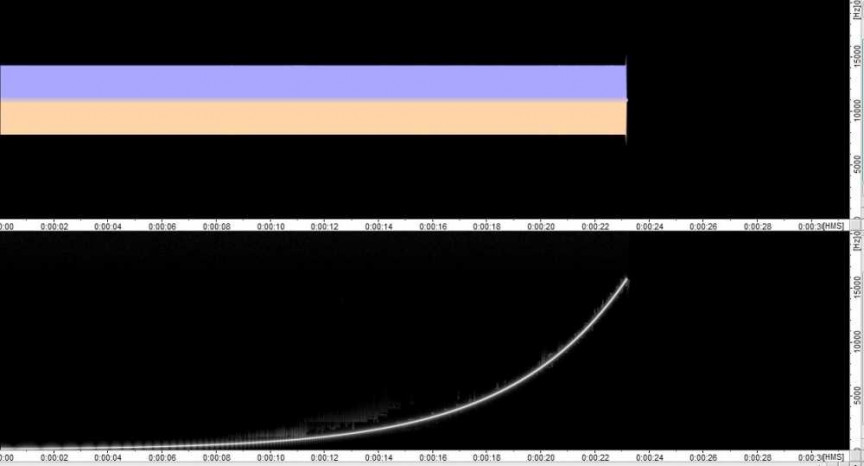
Figure 1 shows a digital recording of the sine wave, sweeping from 20Hz to 15,000Hz. The image is divided into two frames. In the top frame, we see an image of the wave-form; this is constant, since the amplitude of the sine wave sweep was maintained throughout. The bottom frame shows a spectrograph, in which the sine wave can clearly be seen ascending through the frequency range from low to high.
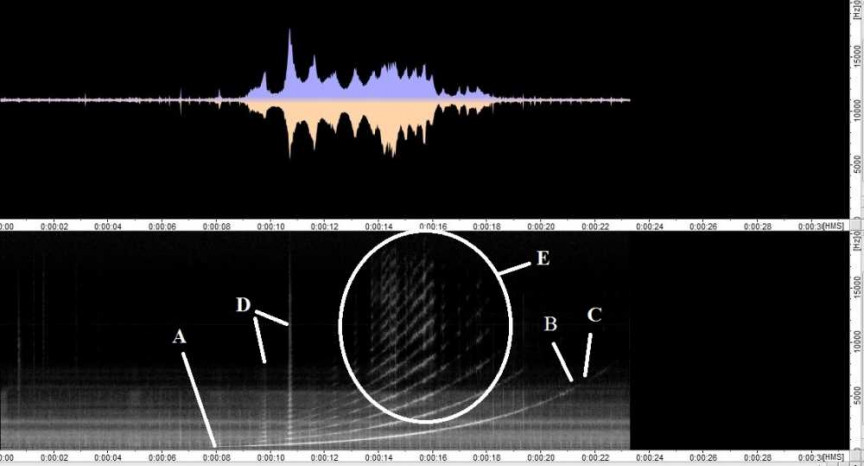
Figure 2 shows exactly the same sine wave, sweeping from 20Hz to 15,000Hz, as it was captured on the Gem phonograph. Point A shows the moment when the sine wave is first registered around 300Hz. Point B shows the moment when the sine wave is suddenly not registered, around 6,000Hz. Point C shows the temporary absence of the sine wave, until it returns again briefly between around 7,000Hz and 8,000Hz. Point D appears to show two sudden bursts of sound, with the first spanning the frequency range from 500Hz to 800Hz, and the second from 500Hz to 20,000Hz. This is surprising, given that the sweeping sine wave does not include any such burst. Although there are potentially multiple ways in which this might be explained, the most plausible explanation is that the phonograph has its own resonant frequency, produced by the mechanism in action. When something resonates at the same frequency, the resulting burst of energy moves both machine and stylus, resulting in a sudden burst of activity appearing on the wax. This suggestion is further supported by reference to point E. Here, the phonograph has produced yet more phantom frequencies, above those of the sweeping sine wave. Rather than spanning the entire frequency range, as they do at point D, they appear intervallic. Without further tests specifically on the nature of phonographs, it is impossible to say much about the intervals involved; it is not clear whether there are any pitch or harmonic relations that hold between these intervals.
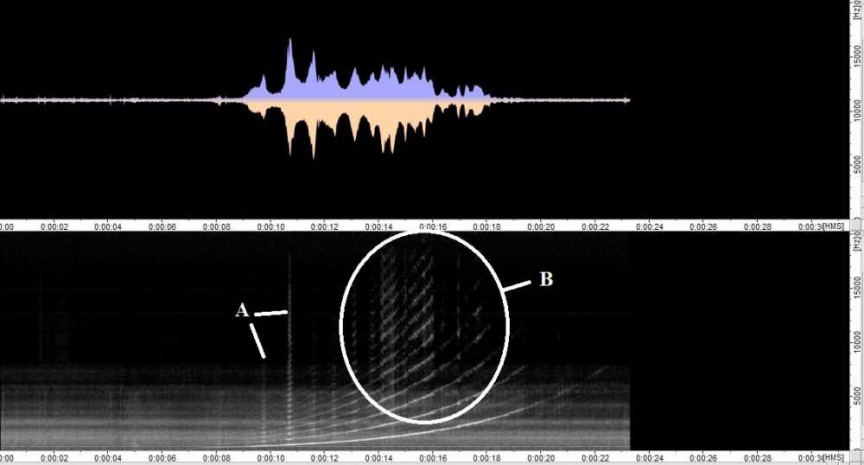
Figure 3 shows the Standard phonograph capturing the same sine wave. Curiously, we can see at point A that exactly the same two bursts of noise have been registered across the frequency range. This is, perhaps, most surprising since it is not merely the same amplitude and burst that have been registered, but the same frequency that has given birth to these events. Point B shows very similar phantom frequencies, registered above the sine wave. In this instance, however, they are slightly clearer, and have a very noticeable vibrato effect shown by the zig-zag appearance of the lines themselves.
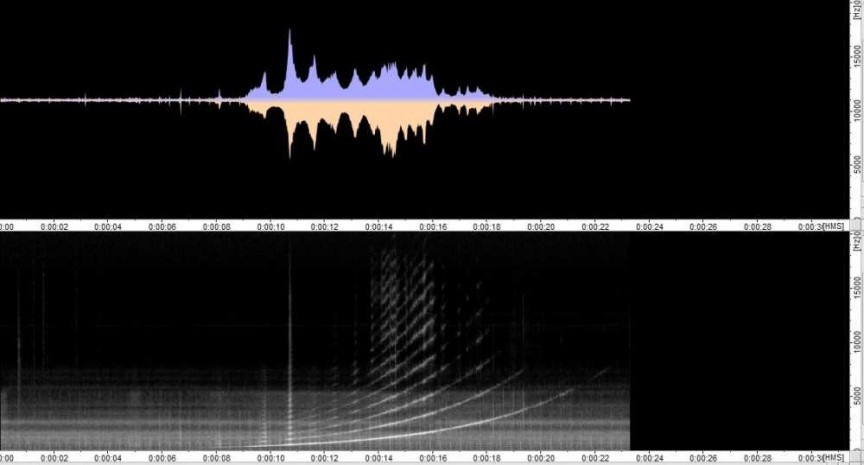
Figure 4, which shows the Triumph recording, is notable only for being almost identical to figures 2 and 3.
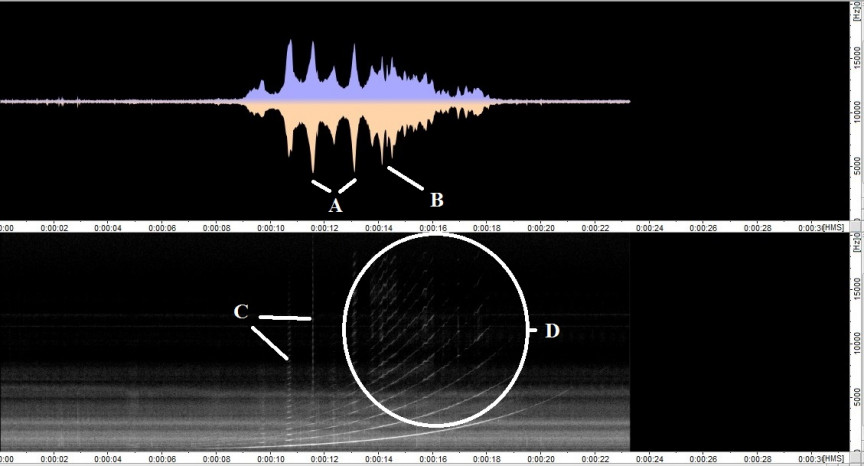
Figure 5, by contrast, shows quite significant differences with the sine wave recorded on the Fireside phonograph. At point A, one can see two peaks that were not previously pronounced; all of the other phonograph recordings appeared to handle frequencies with an almost identical response. Along similar lines, point B shows a region in which there is a degree of clarity in the image that is inconsistent to that registered by the other phonograph machines. Once again, we have two clear bursts of noise, shown at point C. In this instance, however, these differ according to their fundamental frequency from those bursts found elsewhere. Similar phantom frequencies exist above the fundamental. In this case, however, there is substantially less vibrato shown at point D and a much higher degree of clarity to the image at large.
Taken as a whole, these measurements show where the various phonograph machines capture sound most effectively, both in terms of frequency and dynamics. In particular, they demonstrate that the phonograph has the ability to capture sound in the region of 300Hz to 8,000Hz. Despite this, it seems that the mechanism itself is responsible for the production of substantial noise, right across the frequency range; these appear as both bursts of noise, and phantom intervals above a fundamental frequency. Of the models compared, it would seem that the Fireside produces the clearest recording, followed by the Gem, Standard and Triumph, in order. The Fireside also appears to capture a substantially different range of frequencies and, consequently, it would seem that this is a more successful and robust phonograph model. This test subsequently confirmed that the various phonograph models do matter when it comes to replicating a recording and the authors subsequently decided to repeat the experiment once specific pieces, musical instruments and spaces had been determined.
2. Choosing Pieces
The recreations of Block’s recording began with a process of selection; from a several hundred cylinders, we chose four piano recordings to recreate: 1) Anna Esipova performing Benjamin Godard’s Gavotte in G, op. 81 no. 2 (C136, 15 November 1898); 2) Anton Arensky performing his own Nocturne in D flat, op. 36 no. 3 (C114, 25 November 1894); 3) Leonid Kreutzer’s cylinder of Frédéric Chopin’s Mazurka in G minor, op. 67 no. 2 (C141, 1915); 4) Paul Pabst playing Robert Schumann’s ‘Chopin’, from Carnaval, op. 9 (C123, 12 February 1895). These particular recordings were chosen for a practical reason; Inja Stanović, co-author of this article, is a pianist and was therefore able to use her background in historically-informed performance to recreate many of the playing styles and techniques used by the pianists in their original recordings.
Although there is little more to say about this initial stage in the recreation process, it is worth nothing that our decision-making process is clearly at odds with that of the original musicians and recording engineers; it seems reasonable to assume that the pianists were invited to perform something of their choosing, and it is equally likely that they either selected something they knew well, or something that they were already practicing at the time. Either way, it is clear that the two decisions (theirs and ours) are of a different nature, and this brings up a broader issue with the notion of the historically-informed; rather than selecting works with a degree of freedom, as those pianists were likely doing, our choices about what to play were already conditioned.
The four pieces were rehearsed and learned using the original Block recordings as a guide, meaning that the authors aimed for a performance that would draw upon nineteenth century expressive techniques without literally copying how those techniques were applied. Techniques included dislocation between the bass and the melodic line, un-notated arpeggiation, tempo modifications, rhythmic and melodic alterations, and metric rubato.
3. Choosing an Instrument
After deciding which of Block’s recordings to reconstruct, it was necessary to find appropriate instruments. Unfortunately, the search for such instruments was troublesome; Block’s memoirs and letters do not provide any information about the pianos he used for his recordings and, since his cylinders were produced over several decades in different countries, it is safe to assume that multiple instruments were involved. The choice of a suitable piano was therefore guided by the social and cultural status that Block had acquired; a family of Block’s status would surely have owned a grand piano, but Russian instruments of the age were only produced in Russia, and they were not popular in Europe. For this reason, appropriate models, such as Becker, Diedrich and Schreder, were impossible to locate in the UK (where the investigation was conducted).
Without further information on Block’s pianos, decisions had to be made about what would be a suitable instrument for the investigation. Rather than choosing one instrument, however, it was decided that two different instruments would be used, in order that the various recordings may be compared. The first instrument was a Bechstein concert grand, from 1882. This was very large (length 265cm, width 155cm) and extremely powerful. The second instrument was a Streicher made in 1881 (length: 186cm, width: 140cm). This piano was chosen due to its smaller size and, significantly, timbre. It is, of course, unlikely that Block owned either of these particular models, and this does diminish the historical accuracy of our recreations. The decision to record two pianos, however, did prove fruitful; as discussed below, we discovered that there were significant differences between the ways in which the two instruments were captured, and this clearly demonstrates that instrument choices are of fundamental importance in the broader practice of historically-informed recording.
4. Choosing a suitable Space
From his diaries, we know that Julius Block organised public exhibitions of his phonograph at the St. Petersburg Conservatory, the Moscow Conservatory, the Imperial Academy of Sciences, and other universities and scientific societies. As early as October 1889, Block started to organise phonographic evenings, and writes to Edison’s assistant – Charles Batchelor – about Tchaikovsky and his friends from the Conservatoire being amazed with the phonograph. It is possible that some of the various recordings were produced during these public exhibitions. In such cases, the recordings were likely produced in large spaces in front of an audience. The majority of cylinders, however, were recorded at Julius Block’s residences, between 1889 and 1927; based on Block’s journals, and the announcements heard on the cylinders, these include locations in Russia (Moscow and St. Petersburg), Germany (Berlin and Grunewald), and Switzerland (Vevey). Although Block was a wealthy man, these home recordings would surely have been conducted in smaller, furnished spaces. Further details remain unknown.
With the above in mind, the authors decided to record in two different locations, once again with the idea of comparing the two recordings. The first was a large room of approximately 20m by 8m with a stone floor and wooden panels on the walls. The Bechstein was recorded in this particular space; although the instrument was probably larger than those used by Block, there was a good balance between the size of the instrument and the room. The second room was significantly smaller, being 5m by 5m square. The room was furnished with a carpet, plasterboard walls, and ceiling tiles. The Streicher was recorded in this space. Once again, the balance between the instrument’s size and the room seemed appropriate.
Although efforts were made to approximate Block’s recording locations, the precise details remain a mystery. There are, of course, associated factors that will also remain a mystery. For example, we do not know how many people were in each room when the recordings were made. This was presumably fairly significant for the performing musicians, who would most likely have been recording for the very first time. Furthermore, we do not know whether any contextual factors played a part in how sound was registered. For example, we do not know whether Block attempted to control the temperature of the rooms when making his recordings. Cylinders, being made of wax, are subject to changes in different temperatures, and this likely impacts upon whatever may be captured. We conducted a set of tests to establish the impact that the ambient temperature has on cylinders, using cylinders stored at room temperature (20°C), fridge temperature (10°C), and in a portable incubator (set to 30°C). Curiously, the warmest cylinders were the most unsuccessful ones, as large quantities of wax shavings interrupted the stylus cutting the cylinder. There was not much difference between those at room and fridge temperature. Even so, this study confirmed how capricious the wax is as a medium. Sadly, however, the temperature of Block’s cylinders shall never be known.
5. Initial experiments
Once the instruments and recording spaces were determined, a series of additional recordings were produced enabling us to compare and contrast the suitability of each. The following two images show these tests being conducted, with Image 1 showing the Bechstein and Image 2 showing the Streicher.

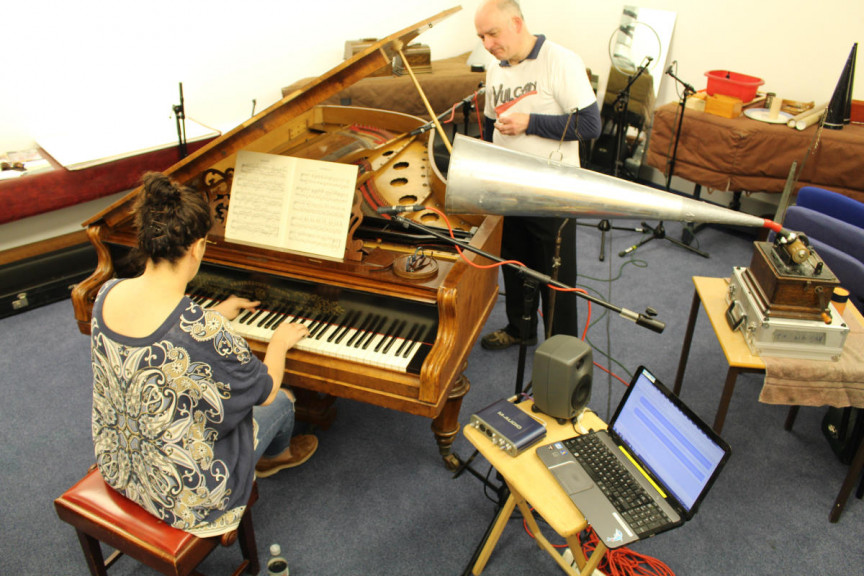
The recordings that were produced during these initial experiments provided two extremely valuable findings. The first finding was that the room did not appear to exert any influence upon the recording itself. This is, mostly likely, because the recording horns were pointing directly into the body of the piano, leaving limited opportunities for any reflections, refractions or absorption from materials and surfaces in the room to enter the horn. Various digital recordings made at same time proved quite different; the Bechstein appears to be in a large, reverberant space whereas the Streicher appears to be in a cupboard-like room. This discovery was particular interesting in the context of Block’s amateur recordings; although the authors of this article believe that these were mostly made in his own properties, and therefore smaller spaces than might otherwise have been used, this appears relatively incidental. The second finding, by contrast, was anything but incidental; differences between the two instruments were very clearly apparent on the recordings. This does not show on a spectrograph or waveform, since the discovery relates to subtle differences in tone and timbre. These differences were significant enough, however, for the two instruments to be identified if one is sufficiently familiar with their characteristic sound. This was, perhaps, surprising, given the amount of surface noise that accompanies a phonograph recording, but it would certainly appear that the characteristic of the instrument chosen is significant to the overall recording. For the purposes of our recreations, the Streicher was ultimately chosen. This was less to do with the characteristic sound of the instrument, and more to do with size of the instrument; it was much easier to record the whole range of this instrument, given that it was substantially smaller than the Bechstein.
6. Recording with the Streicher
Once the instrument and room were chosen, we repeated the initial test replacing the sweep sine wave with a live performance of Chopin’s Mazurka. Findings from this stage would move us closest to determining a suitable phonograph to use for our recreations of Block’s original recordings.
Figure 10 shows our recording with the Edison Gem, 11 shows the Fireside, 12 the Standard and 13 the Triumph. It is worth remembering that these recordings were not made at the same time. Rather, the recordings were made in succession, switching the phonograph model but retaining the same recorder, horn, piano, and room. As one can see from a comparison of the four figures, there are relatively subtle changes between them, including their durations and slight differences between the dynamic ranges, and frequency ranges at given moments. Whilst it is tempting to attribute those differences directly to the phonograph machines, it is equally likely that they might be attributed to the performance styles and, although not included here, images of the concurrent digital recordings are equally varied in terms of what they capture.
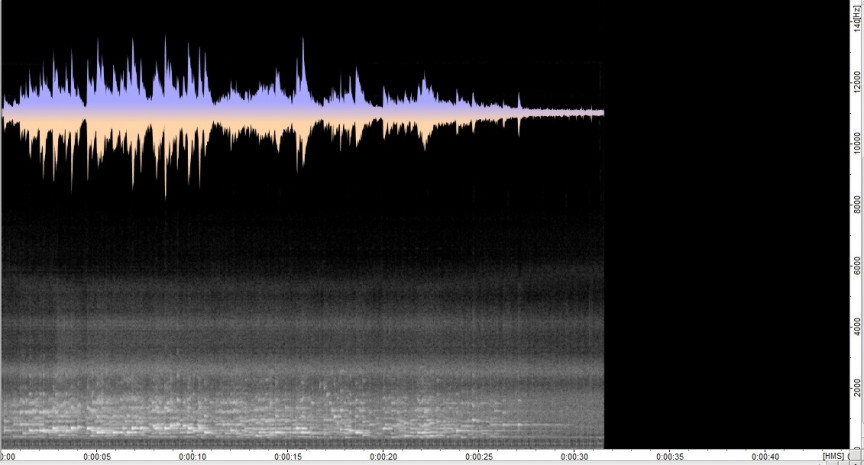
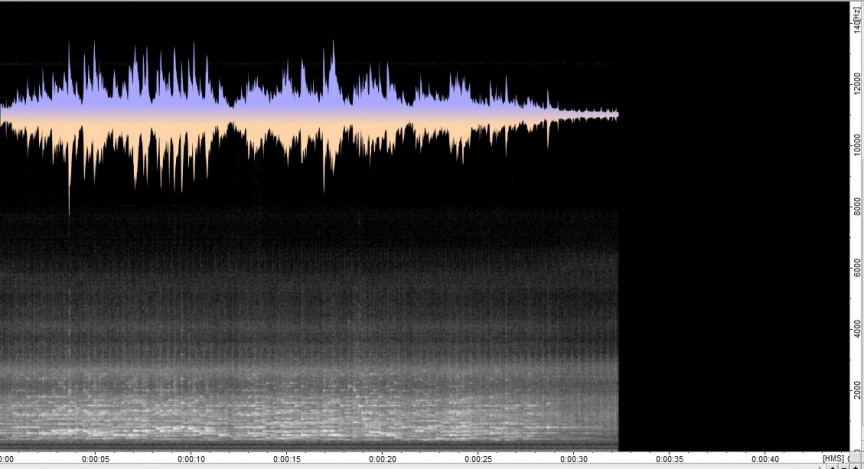
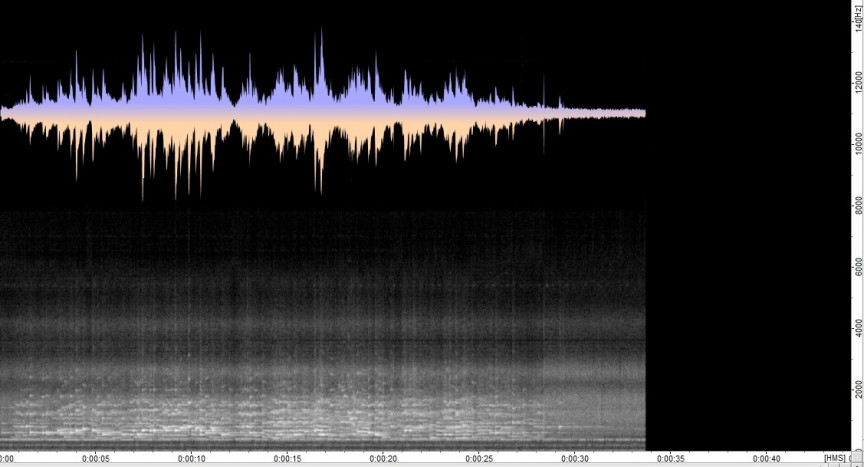

The Fireside is, once again, responsible for producing the clearest recording. In this case, piano notes can be clearly seen at the bottom of the spectrograph and, although present throughout, the background noise is at a minimum and gradually disappears towards the upper frequency range. The Gem is very similar, albeit with some more densely packed bands of noise, and the Standard similar still, but with increased noise. The Triumph is, once again, least successful; this is the only model that has not managed to capture anything below 250Hz. Furthermore, a band of noise around 3,000Hz is registered at almost the same amplitude as the piano notes below. Triumph noise is found across the frequency range and, surprisingly, there is even a band of noise at 13,000Hz.
Prior to conducting this experiment, the authors had assumed that the Edison Standard phonograph would be most similar to Block’s machine; they have a similar build quality, and are of a similar size and weight. These experiments told us two significant things. Firstly, that it does matter which phonograph machine is ultimately used, since the machines themselves vary in their capture, both in terms of the frequency range and the clarity of capture relative to the amount of background noise. Secondly, that the Fireside was closest in quality and sound to Block’s original recordings; not only was this the clearest of the machines tested, but it has a similar band of noise and a similar frequency spread. Armed with this information, we decided to use the Fireside for most of the remaining tests and, ultimately, for the recreation itself.
7. Wax cylinders
In 1930 Block began negotiations with the Phonogramm-Archive at the Ethnologisches Museum in Berlin, hoping that they would preserve his cylinders for future generations. He planned the cylinders to be galvanized in order to preserve them but died before this could happen. Block’s daughter, Nancy, donated 359 original wax cylinders to the Phonogramm-Archiv in Berlin, while his musical scores and manuscripts were donated to Bern University in Switzerland. For years it was believed that Block’s cylinders had been destroyed during the Second World War, until two violinists (John Maltese and John Anthony Maltese) discovered that Block’s cylinders had been confiscated by the Russians, taken to St. Petersburg, and stored in The Phonogram Archive of the Institute of Russian Literature of Academy of Sciences (informally called the Pushkin House).
At the start of our experiment we had assumed that Block was using Edison’s phonographs to make his recordings. In support of this assumption, we have evidence of his orders from Edison. A closer investigation, however, suggested that there may have been other sources for his cylinders. A research trip to visit Block’s cylinders in St. Petersburg, showed that his cylinders vary in colour and texture, as is immediately clear from looking at following photos taken on location:

Unfortunately, it is extremely difficult to assess what this actually means in the context of recording, but it seems reasonable to assume that different cylinders – if they are made from slightly different materials – may have an impact upon what is ultimately captured. In an attempt to understand how different cylinders capture sound, we did a few tests with wax blanks that were produced by Duncan Miller of Vulcan Cylinder Record Company; although the blanks were all produced by the same company, they differed in the constitution of the wax and, accordingly, texture, and thus enabled us to compare and contrast recordings by keeping all other variables consistent. In this instance, graphs of our findings are largely redundant; the recordings varied only in-so-far as some were one or two decibels quieter than the others, and while this may be a consequence of the different cylinders, it is equally possible to imagine that the pianist played slightly louder or quieter on consecutive recordings.
8. Recording horns
On the 26th September 1889, Batchelor sent Block sketches for the recording horn (which he calls a trumpet) that he planned to build, alongside drawings of the grenet cell battery. On the 19th of October 1889, Block informed Edison that he planned to use a horn of around 10 inches in diameter, and asked whether it would be suitable, given that the one used in Edison’s studio was 36 inches (Block to Batchelor 1889). At that time, it was common to make recording horns of various different sizes and materials.
As was now common in our investigation, we were unable to find any further details on Block’s recording horns and, as a consequence, we decided to conduct an experiment to discover the extent to which horns impact upon recorded sound. We had access to six different recording horns that varied in both material and size, noted in the names of the following figures:
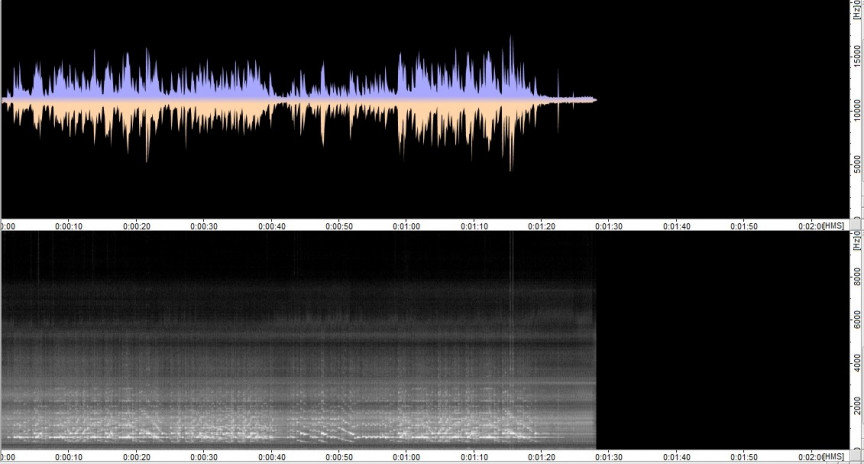

flange) (280mm by 1100mm)
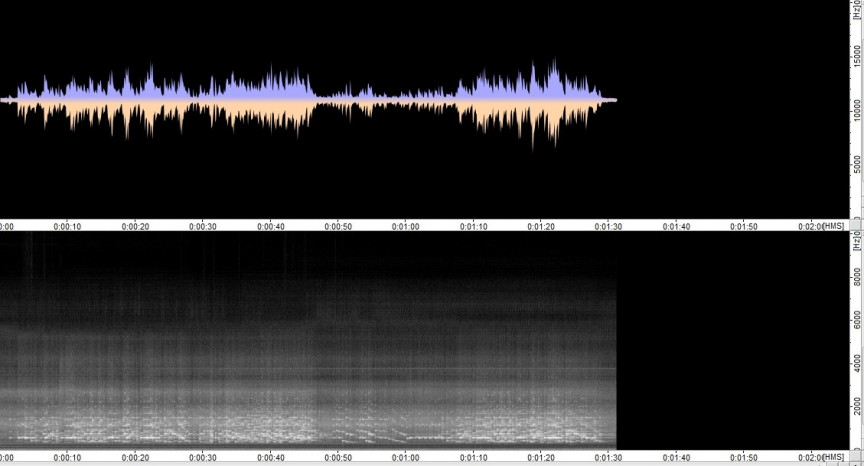
(130mm by 890mm)
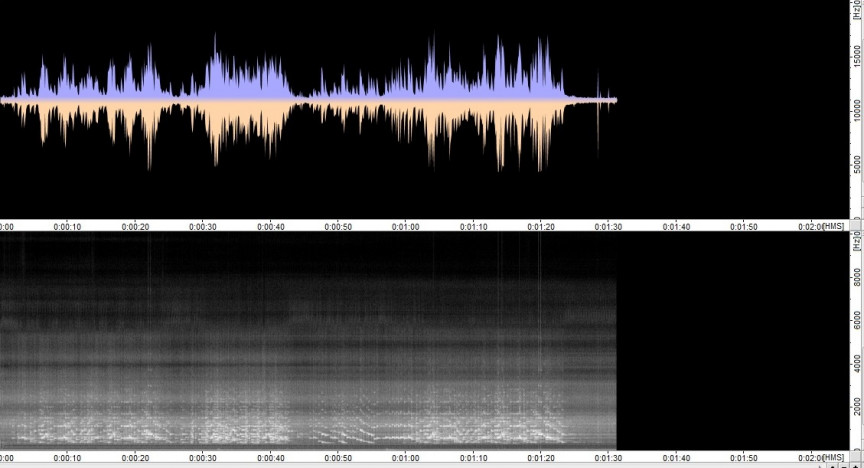
by 355mm)
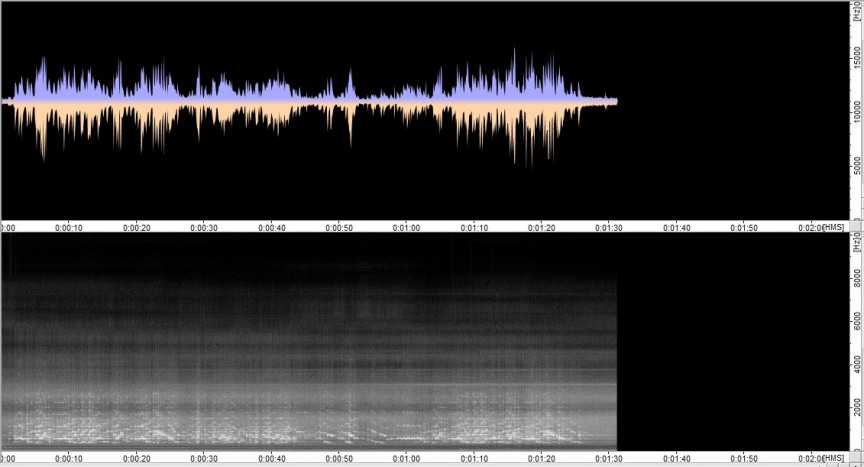
horn (660mm by 190mm)
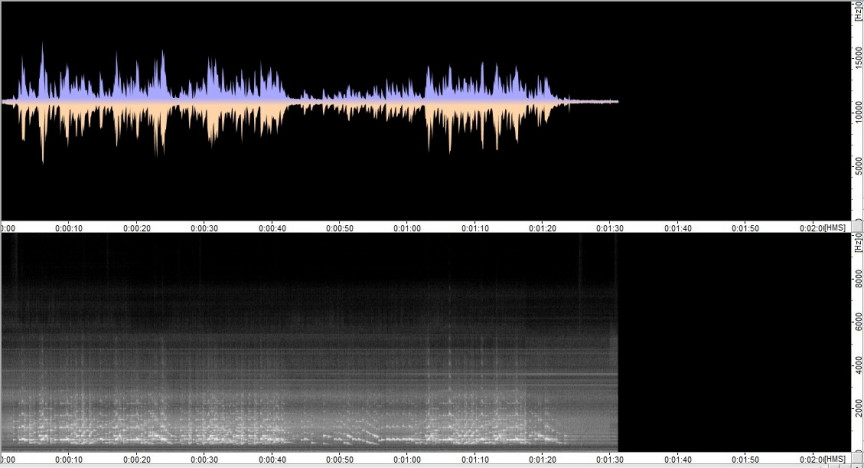
Figures 10 to 15 are included so that the reader might observe the relatively subtle differences between the various horns used to record Arensky’s Nocturne, keeping the phonograph model, recorder, piano and room the same for each recording. Although the relative difference can be observed from the figures, it is worth noting that Figures 10, 11 and 13 have a relatively narrow, and ultimately uniform, frequency spread; none of these horns managed to capture frequencies in the upper regions. Figure 12 is a little clearer, and Figure 14 yet more so. The outstanding horn, in this experiment, was the steel horn shown in Figure 15; the range captured in this instance is quite remarkable for the phonograph, with notes ranging from 300Hz to almost 4,000Hz, and a relatively limited amount of background noise.
This experiment clearly demonstrated that it is not just the phonograph machine that has a dramatic impact upon what is captured; the recording horn has an equally significant impact, largely helping to determine the frequency span and clarity relative to the background noise. These findings are, of course, relative to the recording of a piano, and different horns would likely suit different instruments. Even so, we can clearly state that recording horns have a profound and dramatic effect on what is ultimately registered on the wax. For the purposes of this recording, we determined that the steel horn (480mm by 130mm) approximated the overall frequency range of Block’s recordings, and we decided that this would be used for all subsequent recordings, and the recreations themselves.
9. Horn placement
The specific make and model of the recording horns clearly has an impact on what is registered, but so too does the placement of the horn relative to the chosen instrument. In our case, and presumably in Block’s too, horn placement proved somewhat problematic. The circumference of the horn mouth is relatively narrow and it cannot possibly point at all of the piano strings at the same time. This was only possible if the horn was located at some considerable distance from the piano, at which point it ceased to register sound. Since the horn cannot be moved mid-recording, we were required to select a static position close to the piano, meaning that the mouth of the horn would be directed towards a particular group of strings. A decision on how best to direct the recording horn was determined by what it was able to capture; placement towards the lower strings captured some of the instrument’s bass, but not much of the top end, yet placement towards the top end failed to register any bass at all. This was compounded by the angle of the horn, which initially pointed up towards the lid of the piano, rather than down towards the strings.
A series of tests were conducted, in which the horn was pointed at various different parts of the piano in an effort to capture the entire range of the instrument. We tried recording underneath the instrument, but felt that the result was too muffled. We also tried pointing at the lid of the instrument to see whether indirect sound would be more successful. Ultimately, we determined that the best place for the horn to point was towards the center of the strings, marginally towards the upper register of the instrument, making a balance between direct sound from the strings and the lid of the instrument. In order to achieve this, the phonograph needed to be elevated; as can be seen from Image 2, above, the phonograph is seated on a small table in order that the horn can enter the body of the piano at an angle that achieves this balance.
10. Recorders and diaphragms
Three different recorders were used to record onto the wax cylinder; the first two (the New Edison recorders, both from 1901) used glass diaphragms, varying in thickness, whereas the third was an Automatic recorder. Available from the early 1890’s, the Automatic recorder’s diaphragm automatically responds to the (often imperfect) surface of the wax by producing sympathetic movements of the recorder itself. In theory, this mitigates against deeper or shallower grooves in the wax that are otherwise likely if the recorder is immobile.
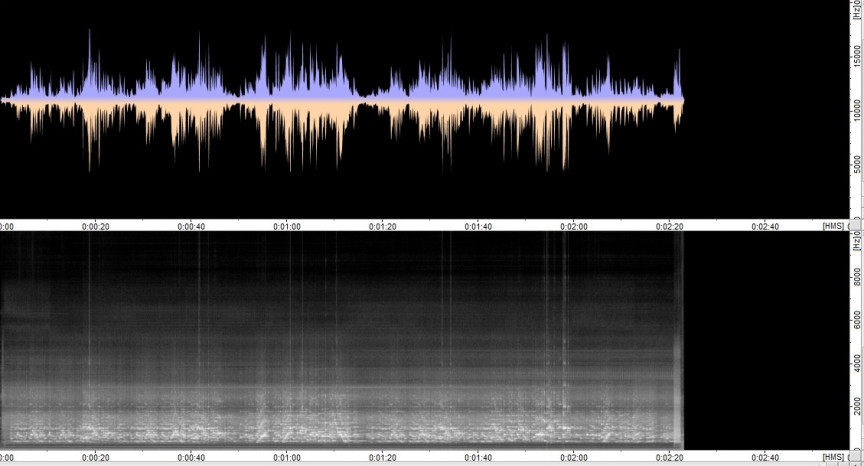
130mm)
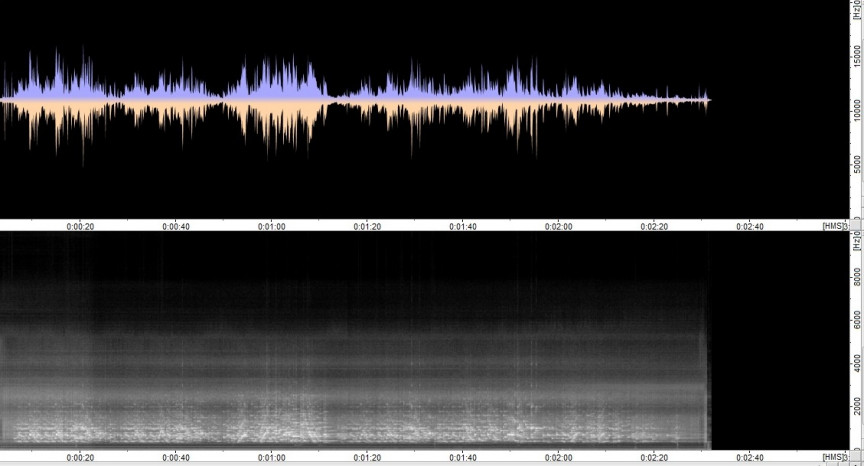
130mm)
Figures 16 and 17 show recordings captured with a glass diaphragm recorder; the horn, phonograph model, piano and room remained unchanged. In many respects, these two figures show a very similar level of capture, in terms of frequency range, amount of background noise, and the dynamic range. Figure 1, which shows the first of the glass diaphragm recorders appears to show the largest dynamic range, and it has certainly produced the most pronounced overall amplitude. Although one might assume that such changes are a consequence of the original performance, this is not borne out by the digital recordings, which show a relatively uniform dynamic range.
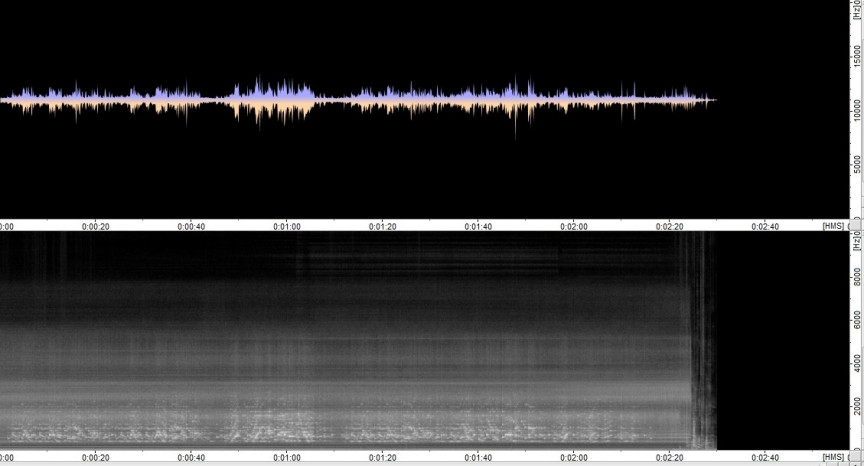
Figure 18 shows the automatic recorder. As is immediately clear from the upper panel, the overall dynamic level is substantially lower than the previous two recorders. Furthermore, it very clearly captured the piano at a lower dynamic, and the spectrograph shows a much smaller dynamic range registered on the wax. Something appears to have malfunctioned around 1’02”; there is a sudden introduction of high-frequency noise in the region of 8,000Hz to 10,000Hz. The reason for this is unknown, and there is nothing to explain this in the digital recording of Chopin’s Mazurka. Either way, it certainly seems from these figures that different recorders have a significant impact upon the dynamic levels and range, yet a minor impact upon the resulting frequency range.
Although it remains unclear which kind of recorder Block was using, the first glass diaphragm was the most sensitive and therefore successful in our experiments. Although it was impossible to compare this particular aspect with Block’s original recordings, we subsequently decided to use this particular recorder in all of our remaining experiments, and the recreations themselves.
11. Performing
Thus far, the discussion has centred upon the technologies employed in the recreations of Block’s cylinders, as if these were the main factors in producing an historically-informed recording. Of equal importance, however, is the performance that is being captured. At this stage, however, we immediately invite discussions about historically-informed performance practice; if the recording is to be historically-informed, then so too must the playing that is registered on the recording. There is insufficient space in an article of this length to fully engage with existing research in the area of historically-informed performance practice, or to unpick the rather complex relationship between recording and performance in this context. It is, however, worth briefly noting a discovery that requires much more attention in future studies; it would appear that performers did have to adjust their playing styles in order to record on cylinder. This observation has profound ramifications for anyone wishing to use early recordings as a source of research evidence, since it calls into question the idea that early recordings document once-upon-a-time performances, suggesting, instead, that there was an element of significant adjustment to those performances in order to ensure that they were registered.
The idea that performers may have adjusted their playing styles when recording crystalised right at the start of this investigation; it became immediately clear that two major adjustments were necessary in order to register sound on the cylinders. The first adjustment related to the overall volume; irrespective of the funnel placement, the cylinder could not register any below mezzoforte, and it was therefore extremely difficult to play everything loud enough so that the sound made an impression in the wax. From a pianistic perspective, this playing requirement was frequently at odds with the pieces being performed, particulary in terms of the Mazurka and Nocturne which would typically demand a much softer delivery. The second adjustment related to the dynamic differences between the two hands; although the horn placement could partially resolve these differences, phonographs struggle to register lower frequencies and, as a result, the left hand was significant quieter than the right.
Two approaches were explored as a means of countering these dynamic differences. The first involved playing the left hand at a significantly increased volume so that it would be registered. Understandably, this was challenging to achieve and again was at odds with the music being performed. Even so, cylinders that were recorded with the left hand booming away managed to achieve something akin to a dynamic balance between the hands when listened back. Although a trick of recording, it is entirely possible that this same approach was chosen by some of Block’s performing musicians in order to achieve something similar. The second approach involved the use of additional expressional techniques; added dislocations and unnotated arpeggiations helped to produce a sense that the performance was more expressive, shaping the music in ways that might otherwise be achieved using dynamic contrasts. This is, perhaps, akin to how harpsichordists use similar expressional techniques to imply dynamic shadings. Although we do not know whether Block’s performing musicians intentionally used such techniques during their own recordings, they are certainly in abundance and match the general style of late nineteenth-century performance practice. There is still a question whether the performers used more of these techniques in order to counter the dynamic consequences of the recording technologies. Whatever the case, the authors of this article were unable to recreate recordings that matched Block’s dynamic balance without requiring substantial changes to the pianists’ performance style. Although this is only one study, the authors of this article believe that this discovery has potentially significant consequences for our understanding of the recorded music that cylinders present. One may, of course, counter that a modern-day pianist would invariably sound different to a pianist from the time of Block’s recordings; while the former needs to make changes for a phonograph recording, the latter may not. While this may be partially true, it is hard to believe that pianists of any age performed with extreme dynamic differences between their hands, for example, when they were not recording.
There are, of course, many other things relating to performance practice that require thought and attention, particularly in terms of the methods and approaches to being historically-informed in this context; if our overall suggestion is correct, and performers did need to adjust their playing approach when using cylinders, then these early forms of evidence may be called into question regarding certain parameters. Other considerations beyond the practice itself are equally significant; unlike the early recording musicians who had probably never encountered recorded sound, for example, modern day musicians wanting to make recordings are invariably influenced by the vast history of recorded music. This fact cannot be overlooked, since it puts the early recording musician in a very different psychological position relative to their modern-day counterpart.
12. Transfers
Although wax cylinders were originally intended to be heard on phonograph machines, they only permit a limited number of repeats before the wax starts to deteriorate, and historic cylinders are prone to chipping, melting and other deteriorating factors such as the growth of surface mould. We should therefore be extremely thankful for the increasing abundance of digital transfers of cylinder recordings that are available online and on various forms of media, including Marston’s CD of Block’s recordings. Transfers did not exist in Block’s time, of course, but they are now an essential part of our means of access, allowing whatever was captured on a given cylinder to be rendered in a digital form for wider dissemination.
Unfortunately, as noted by Stanović (2018) in an article on piano rolls, the processes involved in making transfers are often unknown; although the internet is filled with wonderful examples, when it comes to academic research the transfers need to be approached with a caution. In most cases, we are not aware of the conditions under which the transfers were produced, the condition of the original recording, or the playback speed. Further complicating matters is the fact that both digital and mechanical equipment is usually not provided, and one does not necessarily know whether digital transfers have been edited in post-production; perhaps, for example, surface noise or other ‘unwanted’ elements of the original cylinders have been removed. Transfers do not necessarily provide us with a transparent window onto the original cylinder recording and, given that they are our prime mode of access to the sound world of cylinders, this has the potential to dramatically effect our understanding of, and interaction with, early recordings. More research is needed in order understand the relationship between cylinders and their transfers.
Our visit to see Block’s collection in St Petersburg clearly demonstrated that a number of cylinders are in a very frail condition. Indeed, the cylinders are not played any more and transfers (made at some point in the past) are kept on magnetic tapes. Further to this, there is a certain veil of mystery around the choices of tempi; there are two sets of notes with slightly different tempi, written by two different research teams. Since the cylinders cannot be played, it is very difficult to say which tempi is correct.
We were unable to test all of the various possibilities associated with transfers; since Stanović has already provided a comprehensive account of the issues associated with transfers, however, we might be able to relatively easily grasp the issues associated with their use. In our own experiments, a single reproducing horn (steel, 290mm by 485mm) was used for all of the various transfers. Furthermore, the same reproducer was used throughout and the phonograph machine always matched whichever machine was used to make the initial recording. Transfers were done on-site, and no further processing or transformation of the recording materials were allowed. In short: we attempted to ensure consistency among our transfers, so that they may be easily compared, and we therefore attempted to keep all variables to a minimum.
Despite the above, we did investigate one of the common problems that characterises phonograph transfers, and this is worth a brief mention. One of the major difficulties with using a phonograph, either for the purposes of recording or playing back cylinders, is the lack of control and accuracy over the number of revolutions per minute (rpm); the phonograph does not have a measurement for the number of revolutions per minute and, as a result, most phonograph machines are set through listening alone. During study 1, this was potentially problematic, since the transfers from analogue to digital were made at a later date, and there is no way of knowing whether exactly the same rpm was used in both instances. During study 2, this was much less problematic; transfers were produced on the spot and, as such, the phonograph was not changed or adjusted, and the rpm remained the same for recording and playback.
We planned to make a recording of Godard’s Gavotte made at 160 rpm (using the Fireside, and brass flared horn), transfer it at the same speed, and then create subsequent transfers at 144 rpm and 120 rpm. This would enable one to assess whether there are significant, identifiable differences between the transfers. Such is the difficulty of accurately locating the number of rpm, however, that the three transfers ended up being almost indistinguishable; the initial transfer was thought to be at 160 rpm but turned out to be 158 rpm (confirmed through analysis of the transfer). Transfer two, which was ‘set’ to 144 rpm also measured 158 rpm, thus explaining why there was no audible difference between the first and second transfer. Transfer three was set to 120rpm but turned out to be 154.6 rpm (again confirmed through analysis). There were no further observations about quality or capture worth mentioning.
A similar experiment was attempted the other way around; a phonograph recording, again of Godard’s Gavotte (using the Fireside, Brass flared horn), was produced at a low number of revolutions per minute and was subsequently transferred at a much higher number of revolutions. In this case, the initial recording was set at 120 rpm. Thankfully, this turned out to be close, at 123 rpm. An attempt was made to speed up the recorded cylinder to 160 rpm. This turned out to be 143 rpm. The only observation worth sharing is that the second transfer sounded implausible; the piano sounded at an unnatural frequency and was clearly too fast.
Conclusion
This article introduced the term historically-informed recording in order to describe a practice in which historic recordings are recreated. In doing so, it provided an example of the many and varied challenges that such a practice invites; even though the decision to recreate four of Julius Block’s original cylinder recordings was informed by the prevalence of numerous research sources (primarily his diaries and letters to Thomas Edison), musicological evidence about many of the crucial details of the recordings was, for the most part, impossible to find. The authors were able to determine the specific phonograph machine that Block used, along with some information about his recording horn, but the specific instruments, cutters, cylinders, recording locations, recording contexts, and many related matters remain unknown. A method of experimentation and testing those unknown matters helped to generate a significant number of new discoveries and findings. Among those discoveries: the various makes and models of phonographs differ, as do the horns, recorders and reproducers in their ability to capture pitch, tone, spectrum, amplitude and duration. Certain technologies were clearly more effective than others, producing a broader dynamic range, an increased amplitude, and limited noise, among other such markers of success. The Edison Fireside proved itself to be the most successful in producing the clearest recording, and was even more successful when coupled with the glass diaphragm recorder and a steel horn. Curiously, the phonographs did not merely fail to register certain sounds; they also manage to ‘capture’ sounds that were never actually performed; phantom frequencies emerged on various recordings, suggesting that there is some kind of internal resonance that vibrates through phonograph machines.
The most significant discovery did not relate to any specific piece of technology. Rather, it related to musical performance; we gained valuable insights into what early recording pianists had to do in order to register certain elements of their playing. For example, none of the phonograph models managed to register the low bass notes on the piano unless they were performed at a substantially increased volume. The upper range of the piano, by contrast, registered with ease. Early recordings that appear to have balanced the two hands, therefore, probably involved an extreme exaggeration of the bass on the part of the performer. Further to this, the ways in which the performance had to be negotiated in terms of touch, balance, speed, technique, instrument, and many other associated factors, were so pronounced that they could easily become the subject of a separate article; since early recordings are invaluable sources of evidence within various fields of musical research (Brown 1999; Day 2000; Methuen-Campbell 1981; Peres Da Costa 2012; Philip 1992: 2004), such a discovery may have profound ramifications for their future use.
Before jumping to any particular conclusions about the future value of early recordings, it is worth remembering that this was but one study in the practice of historically-informed recording, and further work is urgently needed if we are to begin explaining how mechanical recording technologies may have influenced recording artists. Future studies in this area should seek therefore to engage a range of different musicians and instruments, a wider pool of recording technologies and recording contexts, including professional studio set-ups (which emerged shortly after the Block-era amateur recordings), and additional testing of the many and varied possibilities that these early technologies afford in terms of capturing sound. This study could not achieve all of this. It is hoped, however, that it has provided a blue-print for others looking to engage in the practice of historically-informed recording by demonstrating how such a practice may unfold and the rich findings that follow.
After getting this far, readers may lament the fact that we have not provided any sound examples of either Block’s recordings or our own recreations. In many ways, this was a deliberate decision; although our recreations are, in our view, surprisingly close to Block’s originals, we cannot claim anything approximating historical authenticity. Our studies proved, above all, that too many factors remain unknown. We used as many sources of evidence as we could find, some educated guess-work, and extensive testing and experimentation, but our resulting studies are certainly not ‘a chip off the old Block’. In conclusion, however, it would seem churlish not to invite readers to enjoy the fruits of our labour; after all, we greatly enjoyed making the recreations, and we have no doubt that these are the first of many to be shared here: https://injastanovic.com/early-recordings/recordings-1/.
Research from this article is a part of ‘(Re)constructing Early Recordings: A Guide for Historically-Informed Performance’, Principal investigator: Dr. Inja Stanović, supported by Leverhulme Trust Early Career Fellowship and the University of Huddersfield, 2017-2021). ECF-2016-720. Thanks to Richard Davies, archivist from Leeds Russian Archive (University of Leeds) for his help accessing Block’s diaries and letters, and to the City of London Phonograph and Gramophone Society for a Richard Taylor Bursary which supported the research trip to the Institute of Russian Literature (Pushkin House), St. Petersburg in February 2020. Thanks to all the amazing people from the Phonogram Archive (Institute of Russian Literature) for all their help and support: Svetlana Viktorovna Podrezova (head of the department), Yuri Ivanovich Marchenko, Alexander Valentinovich Osipov and Elena Ivanovna Yakubovskaya. Thank you to Ward Marston for a very informative and inspiring phone call conducted in September 2018.
